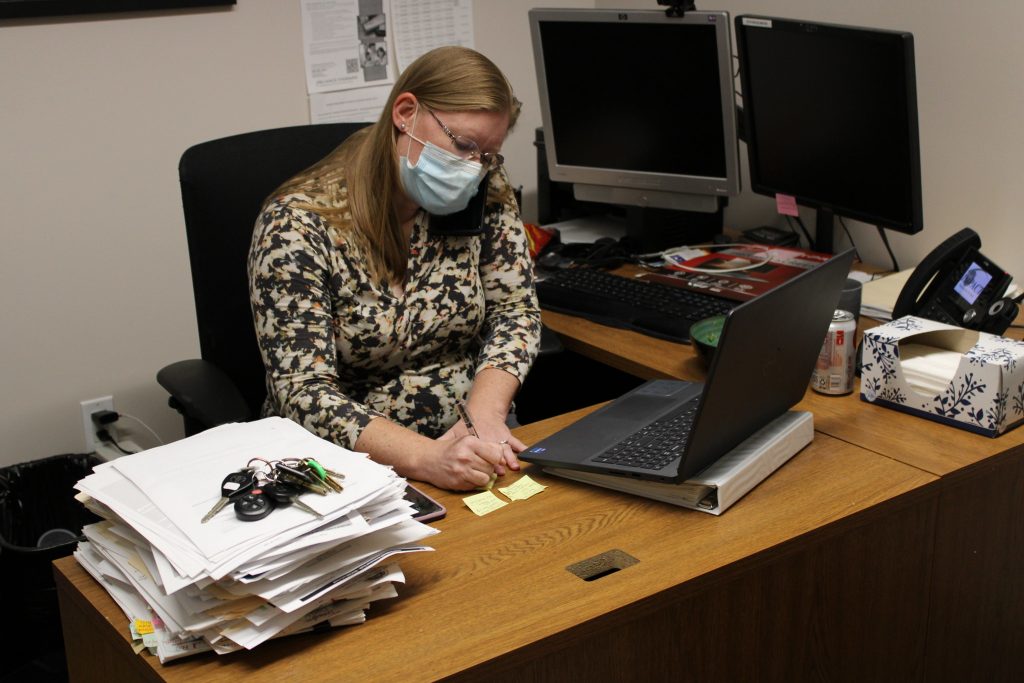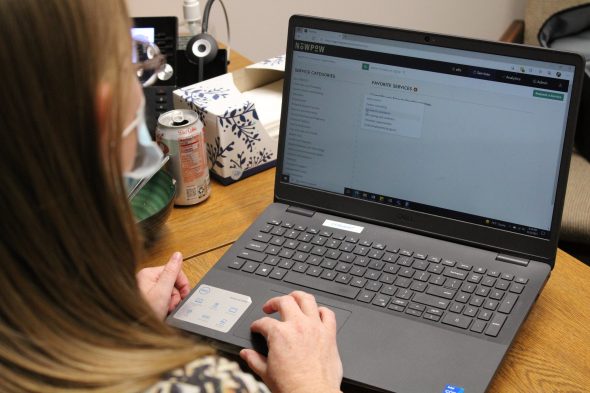Program Eliminates Silos Between Health Care and Social Services
Creators say it makes communication between professionals and with residents more efficient.

Emily Kenney, director of systems change for IMPACT, makes referrals to community resources daily. Now, she’ll be able to do so with one click. Photo by Matt Martinez/NNS.
Health care providers and social service workers in Milwaukee can now better communicate with each other digitally to serve patients with a single click.
Organizers say IMPACT Connect brings residents, local health organizations and social services together more efficiently. One of the partners is IMPACT 2-1-1, a service that functions as an access point for Milwaukee residents to get connected with services.
The goal is to make navigating resources less difficult. It differs from IMPACT 2-1-1, which operates mostly over the phone and digitally, by providing in-person assistance at doctor’s appointments and health screenings, among other services. The program also helps providers confirm that people received services.
This is a collaboration between IMPACT, Froedtert & the Medical College of Wisconsin, Advocate Aurora Health, Sixteenth Street Community Health Centers, United Way of Greater Milwaukee and Waukesha County and the Milwaukee Healthcare Partnership.
The partnership launched Aug. 12 with the Froedtert Health System, although it’s been in development for over three years, said Greg Stadter, program director for the Milwaukee Healthcare Partnership, a co-op of private and public organizations that seeks to improve access to health care for underserved communities.
Emily Kenney, director of systems change for IMPACT, said the new service uses the same resource database as the 2-1-1 system, but it offers more potential for providers to communicate and curate resources together.

Emily Kenney browses the IMPACT Connect digital platform, made by the tech company NowPow. Photo by Matt Martinez/NNS.
By having the partners on a single shared platform, it increases the chances of “closing the loop,” or ensuring patients get the help they need, she said. The tech company NowPow is behind the new digital space.
“We want to make sure we’re actually resolving issues, not making people churn over and over,” Kenney said.
The partnership wants to add more organizations, Kenney said, including smaller resources embedded in the community.
Caitlin Dunn, director of population and digital health for Froedtert Health, said patient care will be a little different because of the new system. People at doctor’s appointments will be asked more questions about their financial and housing stability, for example.
Considering how much of someone’s health is determined by genetics, environment and economic stability, partnering with community organizations only seemed natural, she said.
“There’s a wide recognition that medical care only accounts for about 20% of a person’s health outcome,” Dunn said, noting that the other 80% is affected by their situation outside the medical system. The system will allow Froedtert to screen and refer people on a larger scale.
Deb Heffner, housing strategy director for Community Advocates, said the system will help serve people as a whole when they need services. For the Rental Housing Resource Center, which Heffner coordinates, the program will help realize the goal of making the center a “one-stop shop” for those with housing concerns.
“We all recognize the immense connection between housing and health,” Heffner said. “Now we’ll be able to connect people with a fingertip.”
Stadter said moving some referrals to a face-to-face process will help clients understand the resources better and give more convenient access to information.
Stadter said the program will help open opportunities for social service workers to refer back to health care organizations, which was more difficult before the partnerships were established.
“If it’s just a one-way street, how is the community a meaningful partner?” Stadter asked. “If this provides better access to health care, too, we really see it as a two-way street.”
By connecting the resources, Kenney said everyone at the organizations will be better equipped to help the people they serve. The partners won’t have to rely on the knowledge of one social worker or employee, they will all be on the same wavelength. She views it as a step forward.
“My whole career, the way that people resolve their problems vary based on who they’re connected with,” Kenney said. “I want to end that. I want a system where all the helpers are equipped with the same ability.”
How new program brings health care, social services together with one click was originally published by the Milwaukee Neighborhood News Service.





















